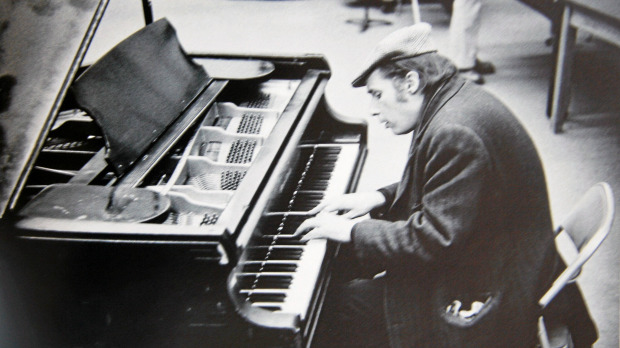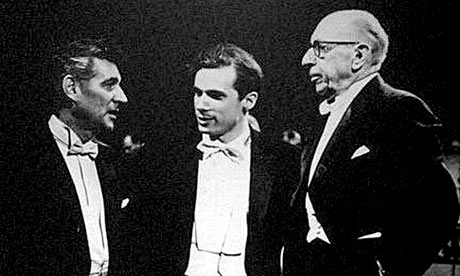The fetish object. The continuous restlessness of meaning. Unresolved tension through which the commodity is continually fetishized, de-fetishized and reproduced to look like the old; warts, scratches, scuffs and all. A reanimation that represents a highlighting of utopian longings dating from antiquity. For real history and social change that lies sleeping, dormant yet patient within the commodity form. The roots of change that are buried and embedded in the parade of an endless stream of new commodity fetishes…..
… a surprisingly common species — people, mostly women, who long for some connection, however tenuous, with the pianist, dead now nearly a quarter century, whom most experts agree was the finest musician Canada ever produced. They’re willing to pay top dollar for any piece of Gouldiana, says Mr. Gross.”A signed photo might go, easily, for $5,000 to $6,000,” he says. “Letters, depending on how interesting the content is, might range up to $3,000 to $5,000. Anything with Gould’s picture and signature would being around $750, at the low end.”…

gould.---Like Leonard Bernstein, Gould saw TV as a way of teaching the masses about classical music. But Bernstein’s Young People’s Concerts series, which ran throughout the 1960s on CBS, was pitched from the ground up, with titles like What Makes Music Symphonic? Gould just went straight for whatever interested him most, and talked about it in detail. One of the mind-blowing things about watching the CBC’s Gould programs is seeing what he could get away with in prime time, from a son-et-lumière discussion of the mystical art of Alexander Scriabin, to two different performances, 13 years apart, of Strauss’s little-known Ophelia Songs. The CBC invested in Gould, and trusted him too, as it has no other classical musician before or since.---Read More:http://www.theglobeandmail.com/news/arts/music/an-archival-showcase-of-glenn-gould-tv-mug/article2194733/
…Material from many other pianists, such as Clara Haskill and Dinu Lipatti, is far more scarce. But Mr. Gould tops the list in terms of the market interest in the detritus of his life….But the signs of continuing fascination with Gould only begin with the high prices people are willing to pay for Gould memorabilia. A woman who was studying music in England had the main theme from Mr. Gould’s String Quartet tattooed on her back….Videos dealing with Mr. Gould’s music-making and life continue to be released. …No other pianist, not Rubinstein, not Horowitz, not Serkin, seems to attract this kind of ongoing fascination….Read More:http://www.canada.com/ottawacitizen/news/observer/story.html?id=865508c0-5a65-45d1-a26e-071d6f367146&p=2
The answer to the enigma falls into the realm of the social sciences.Of which there are no shortage of theories. The buzzword here is celebrity contagion, imitative magic or aura capture, and some ideas pinched from Theodor Adorno and Walter Benjamin on commodity fetish in an age of mechanical reproduction. One almost anthropological theory is that apparently irrational and incoherent yearnings, desires, for a relic is based on instincts essential to surviving disasters such as the Black Plague and other large scale calamities that have afflicted humankind. There is a belief that certain properties are contagious and act as a talisman in either a positive or pernicious way. Drawing on Claude Levi-Strauss, another idea is that magical and pagan ritual documented in so called primitive societies is mirrored in the quest for artifacts driving up their demand….

Paul Waldie:Maybe it’s a reflection of just how unpredictable and unconventional European banks have become. Or maybe it’s just a different way to attract a crowd. But when the Paris-based Euro Banking Association was looking for a Canadian symbol for its booth at a major international banking conference in Toronto this week, the EBA didn’t choose hockey, maple syrup or Mounties. Instead, it turned to Glenn Gould, the Canadian pianist known as much for his eccentricities as his musical genius. The EBA booth at the event, known as Sibos, has an eight-foot high silhouette of Mr. Gould playing piano in his unique style. There’s also a replica of his famous piano chair, which let him sit just over a foot above the floor, and samples of his correspondence and musical scores. “It has created a crowd of people around our stand,” EBA spokesman Daniel Szmukler said. “You don’t see this kind of thing here.” Read More:http://www.theglobeandmail.com/report-on-business/nothing-says-canada-like-glenn-gould/article2171983/
…Some collectors appear to rationalize their purchases as financial investments,assets, or as goods worth owning since they confer status or distinction and perhaps some cognitive and telepathic associations with someone they idolized. But, these are not the central and significant reasons that motivate the purchase of celebrity memorabilia.Its a bit like Churches claiming ownership of Jesus memorabilia: splinters from the cross, shroud of turin, the holy grail …
…No other classical musician of any description seems to have been taken so deeply into the heart of so many listeners, many of whom seem to regard the late pianist virtually as a spiritual mentor, a guru….”It’s the women who seem to fall over themselves about Gould,” says Bob Trenholm, a Gould enthusiast who works in l’Atelier Grigorian, one of Canada’s finest classical music stores, with perhaps the most extensive Gould shelves of any store in the country. …”There is nothing like this for any other classical musician. Maybe, on a smaller scale, for someone like the soprano Maria Callas. But really, the continued obsession with Gould is unique.” Read More:http://www.canada.com/ottawacitizen/news/observer/story.html?id=865508c0-5a65-45d1-a26e-071d6f367146&p=2

---Waldie:“We are trying to change that image when it comes to our brand,” he said. “We feel it’s an industry that is very innovative. It just has the wrong reputation.” Mr. Gould, he said, is a perfect fit because of his brilliance and creativity. “We are actually drawing a direct link between the spirit of creativity and innovation in both of our industries,” he said. “We feel that what we are to our industry, Glenn Gould was to his.”...When asked about Mr. Gould’s famous oddities, such as wearing heavy coats in summer and living an almost hermit-like existence, Mr. Szmukler laughed. “We are seen also as a bit eccentric. We’re not a typical crowd.” Read More:http://www.theglobeandmail.com/report-on-business/nothing-says-canada-like-glenn-gould/article2171983/ image:http://nickholdstock.com/category/delights/
The search for celebrity objects, whether from James Dean, or Ted Bundy, or Goring or Mickey Mantle, reveals a motivation not geared by affection or profit but rather by more abstract and less tangible raeson related to contagious magic and semiotic significance. A feeling that even replicas can radiate their own aura- perhaps what Benjamin would term “weak messianism”- and thus transform them into fetish objects such as Warhol reproductions.
The most important factor appears to be the level of “celebrity contagion.” A
e study found that a sweater owned by a popular celebrity became more important to people if it had actually been worn by their idol. If the pullover had been cleaned it would less valuable to the fans, apparently because the celebrity’s essence had somehow been removed. It does explain the mania in Byron’s England where for example the tomb of Wordsworth was raided for momentos such as bones.

---The most obvious examples come from supernaturalism and religion. Early anthropologists often commented on the tribal fascination with things like fetishes or medicine bundles, usually considering them to be markers of “primitive” culture. They apparently did not notice the same ideas at work in Christianity, which has long trafficked in magical-sacred objects including the Holy Grail, Shroud of Turin, Spear of Destiny, bones of saints, blood of martyrs, splinters of the cross, and most importantly, the Holy Prepuce — Jesus’ circumcised foreskin. In a slightly different vein but working on the same principles, some Jews insist on eating kosher. Although magical objects or relics abound in nearly all religions, even the most committed materalists have similar ideas.--- Read More:http://genealogyreligion.net/the-magic-of-contagion image:http://rendaan.blogspot.com/2010/10/behind-seen.html
ADDENDUM:
Bloom, Diesendruck and Newman found that in all three cases people were willing to pay less than their original value. Like the Perrier and wine examples, the history of the object mattered.
Why do we care so much about origins? To borrow some examples from Bloom; why was a tape measure owned by John F. Kennedy sold for $48,875? Why did Todd McFarlane pay $3 million dollars for Mark McGwire’s seventieth home run? Why do people save their first pair of shoes or favorite teddy bear?…

---Mr Leonard Bernstein’s eloquent disclaimer regarding certain aspects of Mr Glenn Gould’s interpretation of the Brahms No. 1 Piano Concerto, before a concert in April 1962. He was particularly referring to Gould’s insistence that the entire first movement be played at half the indicated tempo. Gould was no lover of public recitals. He called them ‘the last remaining blood sport’. He gave his last public performance in 1964. He was 31. This perhaps give some indication of why he found it distasteful: I believe that the justification of art is the internal combustion it ignites in the hearts of men and not its shallow, externalized, public manifestations. The purpose of art is not the release of a momentary ejection of adrenalin but is, rather, the gradual, lifelong construction of a state of wonder and serenity--- Read More:http://nickholdstock.com/category/delights/
…Bloom’s idea is that we are all essentialists. That is, we pay special attention to the history of an object – where it has been, what it has touched, and who has touched it. As Bloom explains, we subscribe to “the notion that things have an underlying reality or true nature that one cannot observe directly and it is this hidden nature that really matters.” And, moreover, “the pleasure we get from many things and activities is based in part on what we see as their essences.”
Here’s the question that keeps me up at night: why are we essentialists?
I was fortunate enough to sit down with Professor Bloom last month and ask him this question. Below is an abridged transcript from our conversation.
McNerney: Is there an evolutionary advantage of being an essentialist?

---"It sounds crazy, but I almost feel that Glenn is with me in some strange way -- that he's here." Every week, she drives half an hour from her Thornhill home to Mr. Gould's plot in Toronto's Mount Pleasant Cemetery, where she places six or seven roses -- "but always in colours Glenn would have liked, never red or yellow." She's had some inexplicable experiences at the gravesite. Once a Monarch butterfly landed on her shoulder and rested for nearly a minute.--- Read More:http://www.canada.com/ottawacitizen/news/observer/story.html?id=865508c0-5a65-45d1-a26e-071d6f367146&p=2 image:http://www.jmeshel.com/sotw-5-glenn-gould-toccata-in-cm-j-s-bach/
Bloom: I think the case is most obviously made about other people. If I want to safely interact with you, I must be cautious of your history. For example, it is advantageous for me to know how you’ve treated me in the past, who your friends are, who you know and what you know. There is a long list of things that are invisible but are part of you, and they could be important for, say, my survival.
McNerney: So you could say that when we assess others we look at them physically, but we also examine their “resumes,” if you will.
Bloom: Exactly, that’s right. And the same is true with animals. You want to know more than just the physical – the history is important too. For example, is it dangerous? Does it tend to move quickly? Likewise for food, you want to know its history and what it has touched before you eat it.
McNerney: So evolution did not favor people who weren’t able to think as essentialists?
Bloom: Yes, think about what a disadvantage it would be if you only assess things as they are. Here’s the interesting part, you could argue that humans have taken it too far. We are so caught up in history that we collect irrelevant things. We care about the difference between an original and a forgery.
——————————————-
The attraction/repulsion dynamic:
Contagion has a biological basis and deep evolutionary roots in a universal human emotion: disgust. In their article “Dirt, Disgust, and Disease,” Valerie Curtis and Adam Biran explain:
In their exploration of Darwinian medicine, Nesse and Williams (1995) suggest that an instinctive disgust may motivate the avoidance of feces, vomit, and people who may be contagious, and that disgust is one of the mechanisms crafted by natural selection to help us keep our distance from contagion. Pinker (1998) proposes that disgust is “intuitive microbiology,” and that this explains our aversion to objects that have been in contact with disgusting substances: “Since germs are transmissible by contact, it is no surprise that something that touches a yucky substance is itself forever yucky.”
We believe that the line of argument proposed by Nesse and Williams and by Pinker, which explains disgust as an adaptation to the threat of disease, holds the key to the puzzle. Microbes and parasites have always provided a potent selective force driving the evolution of the defenses of higher organisms. Whether micro-parasites, such as viruses, bacteria, and protozoa, or macro-parasites, such as internal worms or external arthropods, these organisms play a role analogous to that of predators in driving adaptation in animal populations.
In the arms race between animals and their parasites, parasite attackers have evolved to exploit all the available ports of entry. Their hosts have evolved to protect these ports with all available defenses. In humans, the airways, the gut, the genitals, and the skin are the four main routes of entry for parasites seeking nourishment and reproductive opportunity.
Over the past decade, geneticists have discovered certain “hot spots” in the human genome — regions where there is evidence of intense and sustained selection pressure. Many of these hot spots code for immune response or regulate the immune system, which is something we would expect in a world filled with invisible pathogens. It is but a short symbolic step from intuitive microbiology (“Gross, don’t touch that!”) to metaphysical veneration (“Awesome, let me rub it!”).Read More:http://genealogyreligion.net/the-magic-of-contagion
———————————
Mr. Maloney, who is now head of the music library at the University of Minnesota, is currently writing a book that will offer the theory that Mr. Gould may have suffered from Asperger syndrome, a neurological disorder on the autism spectrum that he believes may account for certain apparent eccentricities that Mr. Gould had.
And he believes that Mr. Gould’s eccentricities are a good part of what made him fascinating.
“As brilliant a musician as he was, he was certainly seen as a most unusually eccentric and strange individual — and that combination, particularly to us Canadians with our repressed sense of self, made him exotic, which increased our interest.”
The Gouldian eccentricities famously included wearing an overcoat, hat, gloves and galoshes, even in summer.
But Mr. Maloney has no doubt that “sheer musical brilliance” explains most of Mr. Gould’s continuing appeal.
“His recordings, expecially the Bach, had an individualism and a brilliance that I don’t think anyone has ever surpassed. Even Angela Hewitt and Murray Perahia, fine though their work has been, are tame in comparison.” Read More:http://www.canada.com/ottawacitizen/news/observer/story.html?id=865508c0-5a65-45d1-a26e-071d6f367146&p=2








 COMMENTS
COMMENTS



